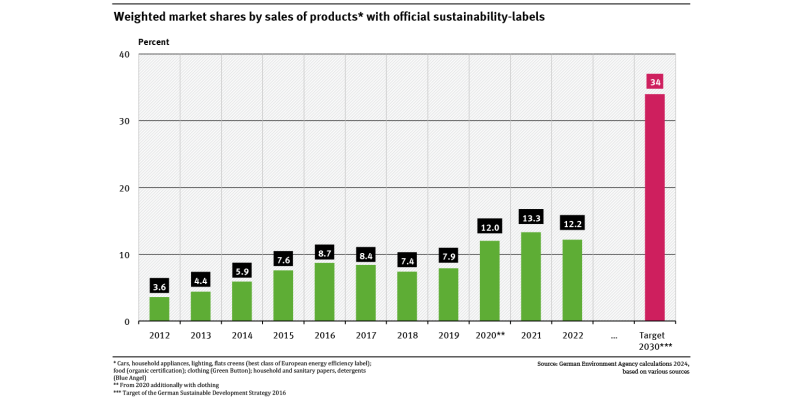Indicator: Environmentally friendly consumption
 Click to enlarge
Click to enlargeSource: German Environment Agency Figure as PDF
 Umweltbundesamt
Umweltbundesamt
 Click to enlarge
Click to enlarge
- In the sector of products with official eco-labels, 12.2% of turnover was generated with particularly environmentally friendly and socially responsible products in 2022.
- The Federal Government has set the target of increasing the market share of these products to 34% by 2030.
- More efforts are needed to achieve this goal, particularly in the food, clothing and mobility sectors.
Private households can encourage sustainable consumption both directly and indirectly. On the one hand energy-efficient vehicles or well-insulated homes need less energy and produce fewer greenhouse gas emissions. On the other hand, by preferring appropriate products, consumers indirectly influence the emissions and social sustainability of the production.
The indicator records the market shares of products with eco-labelling that sets stringent sustainability standards. Up to now, only state-regulated eco-labelling has been considered: Energy labelling (cars, household appliances, lighting and televisions), organic labelling (food), clothing (Grüner Knopf) and the Blue Angel label (sanitary tissues, washing and cleaning products). With this indicator it is possible to ascertain whether conventional products are being replaced by environmentally friendly and socially responsible versions. Sustainable consumption is all about replacing non-sustainable consumer habits with sustainable ones.
In 2022, eco-friendly and socially responsible products had a market share of 12.2% in the product groups surveyed. After a significant increase of 4.1 percentage points in 2020, it is only slightly higher in 2022 than in 2020. This is mainly due to the market share of A+ cars. In 2020, it had risen sharply from 10.0% to 27.5% due to the comprehensive government subsidy. In 2022, however, the market share of 31.2% was only a few percentage points above the 2020 figure. With a market share of 6.3% in 2022, organic food was below the 2020 figure (6.8%). In the case of large household appliances, the values of the most efficient products in the white goods segment only increased by a few percentage points. In the case of tissue paper, market shares are falling for the eighth year in a row to just 10.0% for private households. The market shares within the various product groups differ significantly in some cases. Take household appliances, for example: Washing machines with the highest efficiency class recently had a market share of 95.6%. In contrast, the highest efficiency class had a share of less than 1% for electric cookers and ovens or air conditioners.
In the German Sustainable Development Strategy, the Federal Government has set targets for the market share of environmentally friendly products. These are to increase to 34 % by 2030. This target requires above all a significantly increase of sales of organic food, environmentally and socially responsible clothing and particularly of the market share of electric cars. The weakening growth in energy-efficient products should also be revived.
To calculate the indicator, particularly environmentally and socially relevant product groups for which market data are available were identified in each consumer area. Since the market volumes for individual product groups vary greatly, the market shares were weighted by the volume of sales for the respective market as a whole. This guarantees that the indicator is not distorted by high market shares in small niche markets.
More detailed information: 'Grüne' Produkte: Marktzahlen (in German only).